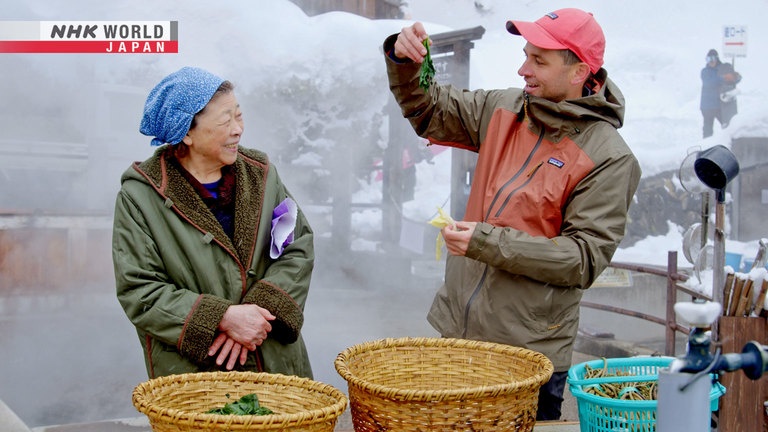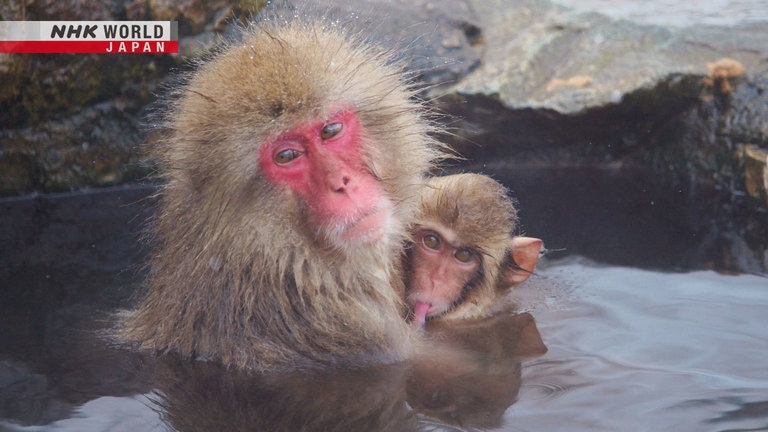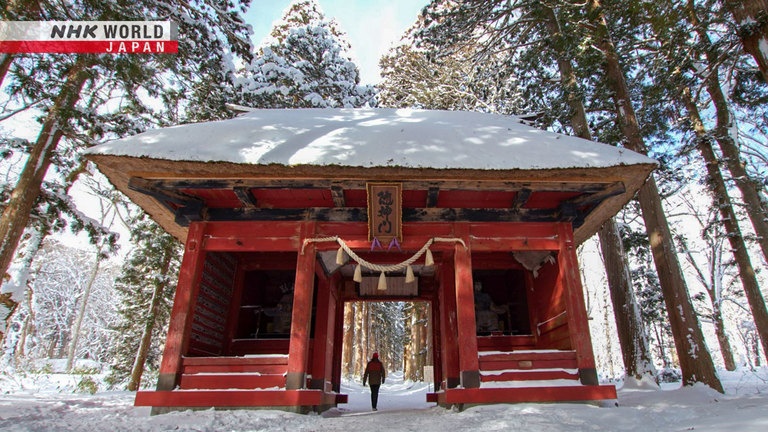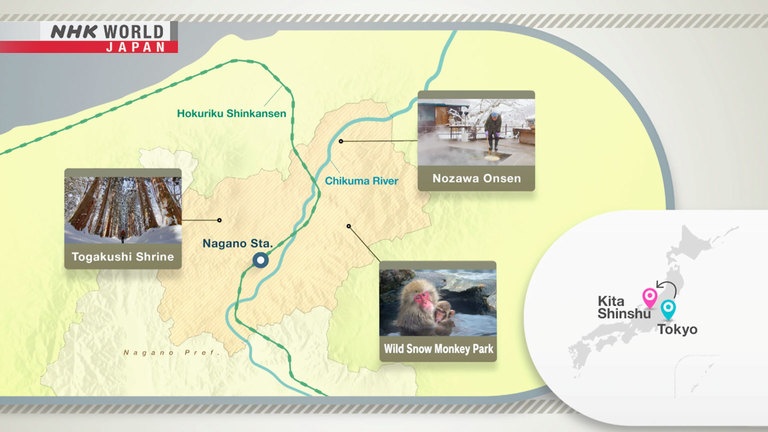Live Long, Live Well in Northern Nagano
Nagano Prefecture, surrounded by beautiful nature, has some of the longest life expectancies in all of Japan. What's behind this? Daniel Moore, an American tour guide living in Nagano, explores his adopted turf to discover the secrets to longevity in one of the country's snowiest regions.
Nozawa Onsen

Jigokudani Wild Snow Monkey Park

Togakushi Shrine

Access

"Journeys in Japan"
Wow, Takizawa-san.
You're so fast! I couldn't keep up!
- So, remind me how old are you?
- I'm 74.
You don't show it!
That's because I love skiing.
Oh, hello!
That man is 91 years old and skis every day.
See you later!
Well, there they go.
Welcome to northern Nagano.
This is the site of the 1998 Winter Olympics.
It's also a mecca for all kinds of snow sports.
It has really good powder snow, lots of ski resorts.
And as you can see, there are a lot of active, healthy people here.
How old are you?
I'm 86.
How old did you say you are?
Eighty!
I'm 81.
I'm 78.
I'm 68.
I'm 77!
On "Journeys in Japan," local guide Daniel Moore
unlocks the secrets to longevity in northern Nagano.
Live long and prosper!
Live Long, Live Well in Northern Nagano
Kita Shinshu, or northern Nagano,
is nearly 250 kilometers northwest of Tokyo.
Daniel Moore, who lives in Nagano, runs an outdoor adventure company.
Alright.
I'm off.
I've been living in Nagano for about eight years now
and I didn't realize the people here
have some of the longest life expectancies in all of Japan.
I'm going to go see some of my favorite spots,
see some people I haven't met in a while,
and see if I can learn their secret to success and long life.
Let's go.
Tons of snow.
Wow, that is so much snow.
As you can see, this is one of the snowiest areas in Japan.
And I wonder if there isn't some kind of connection
between the deep snow and people's long healthy lives.
I really like all the traditional houses in this village.
So much snow though. Way above my head.
Hello.
Hello.
What a lot of snow.
But not as much as usual.
Hard work, no?
I've been doing this since I was young, so I'm in shape.
I can keep doing this.
How old are you?
I'm 86.
You don't look it!
May I help out?
No, that's quite alright.
I insist.
If you insist, let's start here then.
Don't you get sore, doing this every day?
Not really. I'm used to it.
It does seem like good training.
Experts say snow shoveling is great for your health
as it works your entire body like walking, volleyball, and swimming.
Is this designed to help with the snow?
Yes, it helps melt it.
This is called a "fuyukawa," or "winter river."
Most houses in this area have them.
So when the snow falls from the roof it melts easily.
The roofs are covered in tin now, but used to be thatched.
So, you had to shovel it off?
It was a lot of work, but part of our lives.
Were those good memories?
Not at all!
Let's get back to work.
It's hard work but it's really good exercise
and I can see why he's so fit at 86 years old.
These are so cool.
You can only do this in the deep snow country of Japan.
It must take a lot of work to make one though.
Building and maintaining these "kamakura" snow domes is tough work.
And it's done by a team of 60 and 70-somethings.
It's pretty big inside.
And it's definitely a lot warmer than the snowstorm outside.
What is the secret to your health?
This work relieves stress, working together.
And sweating.
We use the snow as an excuse to have fun.
The best thing is that people come here and have fun.
I want to join after retiring.
Please do.
Okay, let's go.
The air feels so good.
I love snow shoeing because unlike hiking,
there's not a single course that you have to follow.
The whole, you know, ski field or mountain is your area
and you can go wherever you want.
And there's nothing like walking on totally fresh snow.
You're the first person to ever walk there.
Snow's pretty challenging to live in, but it's so beautiful.
I love, this just perfectly calm, scenery all around me.
This is very relaxing.
Hello. Mami! Long time no see!
What's brought you?
You're here. Hello, Kiuchi-san.
Daniel's friend Kiuchi Mami works with her father and brother
growing vegetables on the family farm.
What have you got here?
Do you know Jerusalem artichokes?
This one is clean. Try it if you like.
Thanks, "itadakimasu"!
Crunchy.
It's a fruit?
It's a vegetable popular now for its health benefits.
What are you growing now?
"Shungiku" greens and spinach.
We can't grow or sell much in winter,
just enough to cover expenses until spring.
Forty-year farming veteran Kiuchi Junichi...
During off-season, that's December through March,
he delights in oil painting.
Dandelions?
Yes, from the side of the field.
When you live in snow country, signs of spring bring such joy.
Like blossoms.
When I see them, I can't help but paint them.
You only paint during the winter?
Yes, because in the summer I'm farming.
I paint during the winter.
In late March I hold my exhibition.
The day after it's back to farming.
Hello.
What a cozy spot. Nice.
I operate an inn, as well as a cafe and bar.
And I'm a rafting guide and canoe instructor.
I also run a campground. So, I do many things.
It sounds fun. But really, how is the lifestyle?
Many people around here live this way.
Doing what you can when you can, reduces stress.
When I first moved here to Iiyama,
I was working as a kindergarten English teacher.
And my husband and I, we've been running our accommodation business.
I've also started recently taking up guiding.
Very busy, very active and very fun.
I feel people in this area are living closely with nature.
Because they can't change it, they have to flow with it.
I love coming to the Monkey Park.
I've been here many, many, times but it never gets old, actually.
I still love coming.
Every time, I see something different.
This is actually the most monkeys that I've ever seen in the bath at one time,
so that's really cool.
But yeah, you observe and you learn
and you just notice different things about the monkeys every time, so.
I love the Snow Monkey Park.
And I actually bring a lot of visitors here on my tours.
But today, I want to show you something a little different.
First up, is my three favorite "onsens" in northern Nagano.
Number three! Yutaki Onsen, Iiyama.
I love Yutaki Onsen. It's right by the Chikuma River.
You can hear the water rushing by you.
It's surrounded by nature, there's mountains all around.
There's a Japanese garden here.
And there's snow falling on top of me
but I'm nice and warm in this hot spring bath.
And that's why this is one of my favorite onsens.
Number two! Yomase Onsen, Kita Shigakogen.
On a clear day, the wide open views let you see all the way to Nagano City,
which is also great at night.
And the alkaline water feels really good on your skin.
That's why Yomase Onsen is my second favorite onsen in all of northern Nagano.
Wait for it... Number one! Maguse Onsen, Kijimadaira.
Finally, we're at Maguse Onsen, my favorite onsen in northern Nagano.
I love the winter scenery here.
The views behind me are stunning.
The scenery keeps changing in every season, but I especially love the winter.
This is a bath all by itself, it kind of feels like you're in this wild natural setting.
That's why Maguse is my favorite onsen in northern Nagano.
Nozawa's history as a hot spring resort dates back to the eighth century.
It hosts 13 hot spring baths, all free.
All of Nozawa Onsen's baths are open to the public.
However, there are some running costs, of course,
so it's always nice to leave a donation when you use the bath.
It's well known that hot springs have a lot of health benefits.
But here in Nozawa Onsen,
people's lives are especially connected to the hot springs.
The 13 hot spring bath houses are maintained by the residents of their districts.
Thanks to the hot springs I am healthy!
The hot springs serve other lifestyle needs.
Hello!
Why are you boiling vegetables in the onsen?
Because it makes them mild and sweet.
I've just finished. Would you like to try some?
May I?
Spinach.
All in one bite!
It's good. It doesn't have any bitterness.
This has got to be good for your health!
Here we are.
I've cut some up for you.
The village is famous for Nozawana pickles.
I'll try it on its own. Itadakimasu!
Crispy! Delicious.
It's kind of like biting into a crisp apple.
Very crisp and you can really taste it's fibrous and lots of water.
It tastes like it's super healthy.
It's a cruciferous vegetable, it's a fermented food...
So, I want to eat more of this.
Not only because it's healthy but because it's really good too.
What is your secret to staying so active and healthy?
I've avoided illness by enjoying the onsen every day, and eating Nozawana.
I think that is the key.
Nagano has long been synonymous with soba noodles.
Buckwheat's suitability to cold highlands made it a popular crop,
which evolved into this local delicacy.
Hello!
Welcome, come in.
Long time no see!
It's been so long I'm tearing up!
So I'm here with my friend, Kitazawa-san.
She's been making soba here for a lot longer than I've been alive.
She's one of the most fit 80-year-olds that I've ever met.
I can't believe I'm already 80!
There are not many 80-year-olds like you.
It helps that people come to visit me.
A local wild vegetable.
The fibers of "oyamabokuchi," a wild vegetable,
are extracted to use as a binder.
So, Nagano has some of Japan's longest life expectancies.
Yes, diet is the main factor.
That and exercise. And sleep.
My son is four months old, so I'm a little short on sleep.
When did you get married?
I see you've kept busy...
You could say that...
Put out your hand, Daniel. Here you go!
Looks delicious!
I've always intended to continue until I die.
It's important to pass on the things I learned from past generations.
Cut with grace.
This is a nostalgic sound, right?
Soba should be cut thin and long.
Done!
We've got some soba made by the master.
It looks delicious. Now we get to eat it.
Here you go!
Yay!
This is Sugakawa Soba.
It looks so good.
The color is really different than most soba, it's more gray.
I think it's because it's fresh ground soba.
You can see the little dots inside.
Itadakimasu.
You can't make soba this long usually because it gets cut.
Dip it in my sauce.
You have to slurp good soba.
It's so long.
It's very al dente.
It's really kind of almost squeaky.
The little fibers inside.
So good. Just like I remembered.
It's been way too long since I've been here but exactly the same.
She hasn't lost her touch at all.
The steep, rugged mountains of this area
have long been a place for spiritual training.
Here, in Togakushi Shrine,
400-year-old cedar trees line the pilgrimage path.
An 800-year-old cedar.
Live long and prosper!
It's been a fun trip to northern Nagano.
Even though I live and guide here, I feel like I made a lot of new discoveries,
met some cool people,
and had a lot of interesting experiences along the way.
Japan has an aging society,
and sometimes that's seen in a negative light.
But in reality,
older people have a lot of valuable lessons to teach us
about living a happy, healthy life
that I want to try to implement for myself and for my family.
It's been a great trip.
I hope you enjoyed it
and I look forward to seeing you here soon.
From Tokyo, northern Nagano
is a three and a half hour drive,
or an hour and 40 minute train ride
on the Hokuriku Shinkansen.